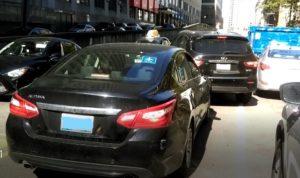 The car horn was relentless. For at least 30 seconds this morning, someone in downtown Chicago was leaning on theirs to send an urgent message.
The car horn was relentless. For at least 30 seconds this morning, someone in downtown Chicago was leaning on theirs to send an urgent message.
With ample time between meetings, I stopped walking to see what the fuss was about. A few car lengths past a busy intersection, just north of the Merchandise Mart, an Uber driver was expressing her angst at the SUV driver a few inches in front of her. The SUV was trying to back into a parking space, but the rear driver was so close behind—only a few inches—that the front driver could not complete the task.
A few minutes went by and traffic clogged the intersection. The Uber driver—let’s call her Angry Driver—intermittently pressed her horn while holding her ground. The next block was now at a standstill.
I walked up to the scene. There was plenty of room for Angry Driver to back up and make way for the SUV. Giving Angry Driver the benefit of the doubt, I informed her that she had plenty of room to put her car into reverse and resolve the problem.
“So now I’m the problem?!” she snapped at me.
“No, I didn’t say you are the problem,” I replied. “The situation is a problem and I am telling you how you can handle the situation.”
“That driver can drive around the block,” she huffed.
Shaking my head, I decided to play traffic conductor. I motioned for oncoming traffic to stop while I waved along a few cars that were stuck behind Angry Driver. But that was only addressing a symptom, not the root cause.
The SUV driver got out of her car and asked Angry Driver if she would please back up just a few inches. A.D. refused to budge.
Then it hit me: time to bring out the Smartphone video recorder. I walked behind Angry Driver and made it clear what I was doing. I noted the sizable gap behind A.D. that would solve the needless stand-off. Within 10 seconds, perhaps sensing the potential PR damage, she grudgingly made the move.
From what I could see, a customer was in the backseat of the Angry Driver vehicle the entire time. Maybe “customer” isn’t the right term—“prisoner” more aptly describes her status for the duration of this avoidable road-rage incident.
For anyone who witnessed this display, the experience likely left a much more powerful impression than the massive advertising campaign that Uber is rolling out. As noted in a San Jose Mercury News story today, “Uber is breaking out the checkbook to spend as much as $500 million on a worldwide ad campaign that is part of the ride-sharing company’s effort to fix an image damaged by at least a year’s worth of corporate controversies.”
Globally, Uber has millions of drivers, and they surely run the gamut in terms of customer service and road courtesy. But it would do well to emphasize to drivers bearing their logo that they are brand ambassadors with boundless potential impact on the company’s image.
Now that is something to get worked up about.
Related Posts:
Street Performance Art vs. PR Principle, Part I
In the Wake of Jared Fogle Scandal, Subway Must Step Up Beyond Lame ‘No Comment’
